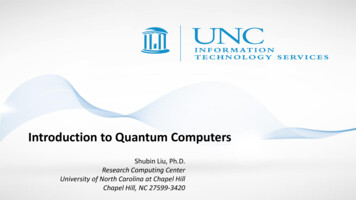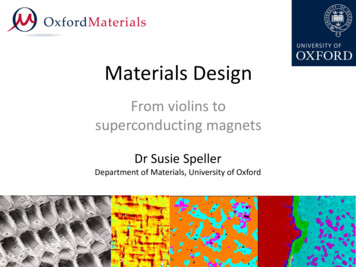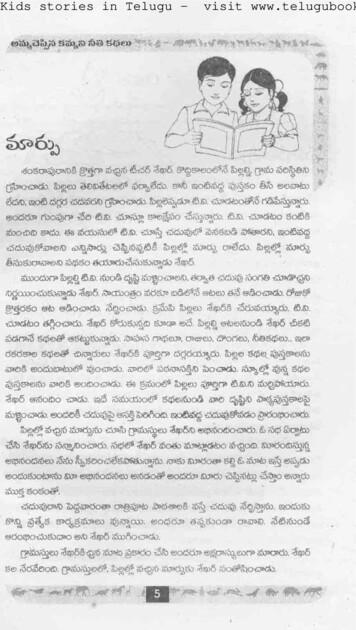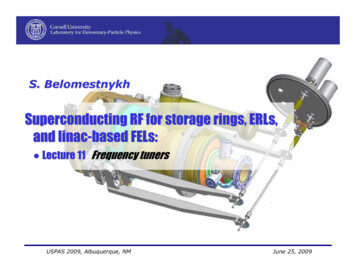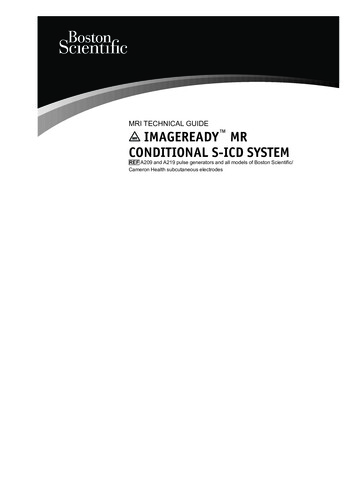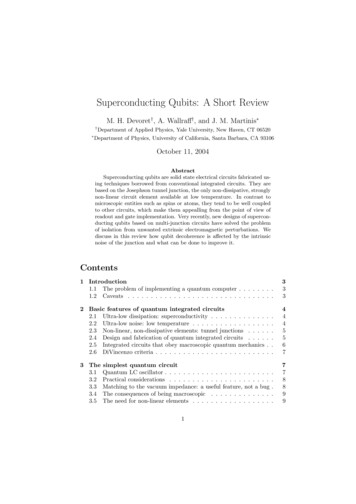
Transcription
Superconducting Qubits: A Short ReviewM. H. Devoret† , A. Wallraff† , and J. M. Martinis † Department of Applied Physics, Yale University, New Haven, CT 06520Department of Physics, University of California, Santa Barbara, CA 93106October 11, 2004AbstractSuperconducting qubits are solid state electrical circuits fabricated using techniques borrowed from conventional integrated circuits. They arebased on the Josephson tunnel junction, the only non-dissipative, stronglynon-linear circuit element available at low temperature. In contrast tomicroscopic entities such as spins or atoms, they tend to be well coupledto other circuits, which make them appealling from the point of view ofreadout and gate implementation. Very recently, new designs of superconducting qubits based on multi-junction circuits have solved the problemof isolation from unwanted extrinsic electromagnetic perturbations. Wediscuss in this review how qubit decoherence is affected by the intrinsicnoise of the junction and what can be done to improve it.Contents1 Introduction1.1 The problem of implementing a quantum computer . . . . . . . .1.2 Caveats . . . . . . . . . . . . . . . . . . . . . . . . . . . . . . . .3332 Basic features of quantum integrated circuits2.1 Ultra-low dissipation: superconductivity . . . . . . . . . . . .2.2 Ultra-low noise: low temperature . . . . . . . . . . . . . . . .2.3 Non-linear, non-dissipative elements: tunnel junctions . . . .2.4 Design and fabrication of quantum integrated circuits . . . .2.5 Integrated circuits that obey macroscopic quantum mechanics2.6 DiVincenzo criteria . . . . . . . . . . . . . . . . . . . . . . . .3 The3.13.23.33.43.5.4445567simplest quantum circuitQuantum LC oscillator . . . . . . . . . . . . . . . . . . . . . . .Practical considerations . . . . . . . . . . . . . . . . . . . . . .Matching to the vacuum impedance: a useful feature, not a bugThe consequences of being macroscopic . . . . . . . . . . . . .The need for non-linear elements . . . . . . . . . . . . . . . . .7788991
4 The Josephson non-linear inductance104.1 Constitutive equation . . . . . . . . . . . . . . . . . . . . . . . . 104.2 Other forms of the parameter describing the Josephson non-linearinductance . . . . . . . . . . . . . . . . . . . . . . . . . . . . . . . 114.3 Tuning the Josephson element . . . . . . . . . . . . . . . . . . . . 125 The quantum isolated Josephson junction125.1 Form of the hamiltonian . . . . . . . . . . . . . . . . . . . . . . . 125.2 Fluctuations of the parameters of the hamiltonian . . . . . . . . 136 Why three basic types of Josephson qubits?6.1 The Cooper pair box . . . . . . . . . . . . . . . . . . . . . .6.2 The RF-SQUID . . . . . . . . . . . . . . . . . . . . . . . . .6.3 Current-biased junction . . . . . . . . . . . . . . . . . . . .6.4 Tunability versus sensitivity to noise in control parameters .6.5 Non-linearity versus sensitivity to intrinsic noise . . . . . .7 Qubit relaxation and decoherence.141417192122228 Readout of superconducting qubits238.1 Formulation of the readout problem . . . . . . . . . . . . . . . . 238.2 Requirements and general strategies . . . . . . . . . . . . . . . . 248.3 Phase qubit: tunneling readout with a DC-SQUID on-chip amplifier. . . . . . . . . . . . . . . . . . . . . . . . . . . . . . . . . . 258.4 Cooper-pair box with non-linear inductive readout: the “Quantronium” circuit . . . . . . . . . . . . . . . . . . . . . . . . . . . . . 268.5 3-junction flux qubit with built-in readout . . . . . . . . . . . . . 278.6 Avoiding on-chip dissipation with dispersive readout schemes . . 288.7 Cooper-pair box with circuit quantum electrodynamics readout . 309 Coupling superconducting qubits3110 Can coherence be improved with better materials?3211 Concluding remarks and perspectives33A Quantum circuit theory34B Eigenenergies and eigenfunctions of the Cooper pair box36C Relaxation and decoherence rates for a qubit37C.1 Definition of the rates . . . . . . . . . . . . . . . . . . . . . . . . 37C.2 Expressions for the rates . . . . . . . . . . . . . . . . . . . . . . . 372
11.1IntroductionThe problem of implementing a quantum computerThe theory of information has been revolutionized by the discovery that quantum algorithms can run exponentially faster than their classical counterparts,and by the invention of quantum error-correction protocols [1]. These fundamental breakthroughs have lead scientists and engineers to imagine buildingentirely novel types of information processors. However, the construction of acomputer exploiting quantum – rather than classical – principles represents aformidable scientific and technological challenge. While quantum bits must bestrongly inter-coupled by gates to perform quantum computation, they must atthe same time be completely decoupled from external influences, except duringthe write, control and readout phases when information must flow freely in andout of the machine. This difficulty does not exist for the classical bits of anordinary computer, which each follow strongly irreversible dynamics that dampthe noise of the environment.Most proposals for implementing a quantum computer have been based onqubits constructed from microscopic degrees of freedom: spin of either electronsor nuclei, transition dipoles of either atoms or ions in vacuum. These degreesof freedom are naturally very well isolated from their environment, and hencedecohere very slowly. The main challenge of these implementations is enhancingthe inter-qubit coupling to the level required for fast gate operations withoutintroducing decoherence from parasitic environmental modes and noise.In this review, we will discuss a radically different experimental approachbased on “quantum integrated circuits.” Here, qubits are constructed from collective electrodynamic modes of macroscopic electrical elements, rather thanmicroscopic degrees of freedom. An advantage of this approach is that thesequbits have intrinsically large electromagnetic cross-sections, which implies theymay be easily coupled together in complex topologies via simple linear electricalelements like capacitors, inductors, and transmission lines. However, strongcoupling also presents a related challenge: is it possible to isolate these electrodynamic qubits from ambient parasitic noise while retaining efficient communication channels for the write, control, and read operations? The main purposeof this article is to review the considerable progress that has been made in thepast few years towards this goal, and to explain how new ideas about methodology and materials are likely to improve coherence to the threshold needed forquantum error correction.1.2CaveatsBefore starting our discussion, we must warn the reader that this review isatypical in that it is neither historical nor exhaustive. Some important workshave not been included or are only partially covered. We amply cite workby our own, at the risk of irritating the reader, but we wanted to base ourspeculations on experiments whose details we fully understand. We have on3
purpose narrowed our focus: we adopt the point of view of an engineer trying todetermine the best strategy for building a reliable machine given certain designcriteria. This approach obviously runs the risk of presenting a biased and evenincorrect account of recent scientific results, since the optimization of a complexsystem is always an intricate process with both hidden passageways and deadends. We hope nevertheless that the following sections will at least stimulatediscussions on how to harness the physics of quantum integrated circuits into amature quantum information processing technology.22.1Basic features of quantum integrated circuitsUltra-low dissipation: superconductivityFor an integrated circuit to behave quantum mechanically, the first requirementis the absence of dissipation. More specifically, all metallic parts need to bemade out of a material that has zero resistance at the qubit operating temperature and at the qubit transition frequency. This is essential in order forelectronic signals to be carried from one part of the chip to another withoutenergy loss – a necessary (but not sufficient) condition for the preservation ofquantum coherence. Low temperature superconductors such as aluminium orniobium are ideal for this task [2]. For this reason, quantum integrated circuitimplementations have been nicknamed “superconducting qubits”1 .2.2Ultra-low noise: low temperatureThe degrees of freedom of the quantum integrated circuit must be cooled totemperatures where the typical energy kT of thermal fluctuations is much lessthat the energy quantum ω 01 associated with the transition between the states qubit 0 and qubit 1 . For reasons which will become clear in subsequentsections, this frequency for superconducting qubits is in the 5-20 GHz rangeand therefore, the operating temperature temperature T must be around 20mK (Recall that 1 K corresponds to about 20 GHz). These temperatures maybe readily obtained by cooling the chip with a dilution refrigerator. Perhapsmore importantly though, the “electromagnetic temperature” of the wires of thecontrol and readout ports connected to the chip must also be cooled to theselow temperatures, which requires careful electromagnetic filtering. Note thatelectromagnetic damping mechanisms are usually stronger at low temperaturesthan those originating from electron-phonon coupling. The techniques [3] andrequirements [4] for ultra-low noise filtering have been known for about 20 years.From the requirements kT ω 01 and ω01 , where is the energy gap1 In principle, other condensed phases of electrons, such as high-Tc superconductivity orthe quantum Hall effect, both integer and fractional, are possible and would also lead toquantum integrated circuits of the general type discussed here. We do not pursue this subjectfurther than this note, however, because dissipation in these new phases is, by far, not as wellunderstood as in low-Tc superconductivity.4
of the superconducting material, one must use superconducting materials witha transition temperature greater than about 1K.2.3Non-linear, non-dissipative elements: tunnel junctionsQuantum signal processing cannot be performed using only purely linear components. In quantum circuits, however, the non-linear elements must obey theadditional requirement of being non-dissipative. Elements like PIN diodes orCMOS transistors are thus forbidden, even if they could be operated at ultra-lowtemperatures.There is only one electronic element that is both non-linear and non-dissipativeat arbitrarily low temperature: the superconducting tunnel junction2 (alsoknown as a Josephson tunnel junction [5]). As illustrated in Fig. 1, this circuit element consists of a sandwich of two superconducting thin films separatedby an insulating layer that is thin enough (typically 1 nm) to allow tunneling ofdiscrete charges through the barrier. In later sections we will describe how thetunneling of Cooper pairs creates an inductive path with strong non-linearity,thus creating energy levels suitable for a qubit. The tunnel barrier is typicallyfabricated from oxidation of the superconducting metal. This results in a reliable barrier since the oxidation process is self-terminating [7]. The materialsproperties of amorphous aluminum oxide, alumina, make it an attractive tunnelinsulating layer. In part because of its well-behaved oxide, aluminum is thematerial from which good quality tunnel junctions are most easily fabricated,and it is often said that aluminium is to superconducting quantum circuits whatsilicon is to conventional MOSFET circuits. Although the Josephson effect is asubtle physical effect involving a combination of tunneling and superconductivity, the junction fabrication process is relatively straightforward.2.4Design and fabrication of quantum integrated circuitsSuperconducting junctions and wires are fabricated using techniques borrowedfrom conventional integrated circuits3 . Quantum circuits are typically made onsilicon wafers using optical or electron-beam lithography and thin film deposition. They present themselves as a set of micron-size or sub-micron-size circuitelements (tunnel junctions, capacitors, and inductors) connected by wires ortransmission lines. The size of the chip and elements are such that, to a largeextent, the electrodynamics of the circuit can be analyzed using simple transmission line equations or even a lumped element approximation. Contact to thechip is made by wires bonded to mm-size metallic pads. The circuit can bedesigned using conventional layout and classical simulation programs.2 A very short superconducting weak link (see for instance Ref. [6]) is a also a possiblecandidate, provided the Andreev levels would be sufficiently separated. Since we have toofew experimental evidence for quantum effects involving this device, we do not discuss thisotherwise important matter further.3 It is worth mentioning that chips with tens of thousands of junctions have been successfullyfabricated for the voltage standard and for the Josephson signal processors, which are onlyexploiting the speed of Josephson elements, not their quantum properties.5
a) b)!Figure 1: a) Josephson tunnel junction made with two superconducting thinfilms; b) Schematic representation of a Josephson tunnel junction. The irreducible Josephson element is represented by a cross.Thus, many of the design concepts and tools of conventional semiconductorelectronics can be directly applied to quantum circuits. Nevertheless, there arestill important differences between conventional and quantum circuits at theconceptual level.2.5Integrated circuits that obey macroscopic quantummechanicsAt the conceptual level, conventional and quantum circuits differ in that, in theformer, the collective electronic degrees of freedom such as currents and voltagesare classical variables, whereas in the latter, these degrees of freedom mustbe treated by quantum operators which do not necessarily commute. A moreconcrete way of presenting this rather abstract difference is to say that a typicalelectrical quantity, such as the charge on the plates of a capacitor, can be thoughtof as a simple number in conventional circuits, whereas in quantum circuits, thecharge on the capacitor must be represented by a wave function giving theprobability amplitude of all charge configurations. For example, the charge onthe capacitor can be in a superposition of states where the charge is both positiveand negative at the same time. Similarly the current in a loop might be flowingin two opposite directions at the same time. These situations have originallybeen nicknamed ”macroscopic quantum coherence”effects by Tony Leggett [8] toemphasize that quantum integrated circuits are displaying phenomena involvingthe collective behavior of many particles, which are in contrast to the usualquantum effects associated with microscopic particles such as electrons, nucleior molecules4 .4 These microscopic effects determine also the properties of materials, and explain phenomena such as superconductivity and the Josephson effect itself. Both classical and quantum6
2.6DiVincenzo criteriaWe conclude this section by briefly mentioning how quantum integrated circuitssatisfy the so-called DiVicenzo criteria for the implementation of quantum computation [9]. The non-linearity of tunnel junctions is the key property ensuringthat non-equidistant level subsystems can be implemented (criterion # 1: qubitexistence). As in many other implementations, initialization is made possible(criterion #2: qubit reset) by the use of low temperature. Absence of dissipation in superconductors is one of the key factors in the quantum coherence ofthe system (criterion # 3: qubit coherence). Finally, gate operation and readout (criteria #4 and #5) are easily implemented here since electrical signalsconfined to and traveling along wires constitute very efficient coupling methods.33.1The simplest quantum circuitQuantum LC oscillatorWe consider first the simplest example of a quantum integrated circuit, the LCoscillator. This circuit is shown in Fig. 2, and consists of an inductor L connected to a capacitor C, all metallic parts being superconducting. This simplecircuit is the lumped-element version of a superconducting cavity or a transmission line resonator (for instance, the link between cavity resonators and LCcircuits is elegantly discussed by Feynman [10]). The equations of motion ofthe LC circuit are those of an harmonic oscillator. It is convenient to takethe position coordinate as being the flux Φ in the inductor, while the role ofconjugate momentum is played by the charge Q on the capacitor playing therole of its conjugate momentum. The variables Φ and Q have to be treated ascanonically conjugate quantum operators that obey [Φ, Q] i . The hamiltonian of the circuit is H Φ2 /2L Q2/2C, which can be equivalently written asH ω 0 (n 1/2) where n is the number operator for photons in the resonatorand ω 0 1/ LC is the resonance frequency of the oscillator. It is importantto note that the parameters of the circuit hamiltonian are not fundamental constants of Nature. They are engineered quantities with a large range of possiblevalues which can be modified easily by changing the dimensions of elements,a standard lithography operation. It is in this sense, in our opinion, that thesystem is unambiguously “macroscopic”. The other important combinationofpthe parameters L and C is the characteristic impedance Z L/C of thecircuit. When we combine this impedance with the residual resistance of thecircuit and/or its radiation losses, both of which we can lump into a resistanceR, we obtain the quality factor of the oscillation: Q R/Z. The theory of theharmonic oscillator shows that a quantum superposition of ground state andfirst excited state decays on a time scale given by 1/RC. This last equalityillustrates the general link between a classical measure of dissipation and theupper limit of the quantum coherence time.circuits share this bottom layer of microscopic quantum mechanics.7
"#Figure 2: Lumped element model for an electromagnetic resonator: LC oscillator.3.2Practical considerationsIn practice, the circuit shown in Fig. 2 may be fabricated using planar components with lateral dimensions around 10 µm, giving values of L and C approximately 0.1 nH and 1 pF, respectively, and yielding ω 0 /2π ' 16GHz andZ0 10 Ω. If we use aluminium, a good BCS superconductor with transitiontemperature of 1.1 K and a gap /e ' 200 µV , dissipation from the breakingof Cooper pairs will begin at frequencies greater than 2 /h ' 100GHz. Theresidual resistivity of a BCS superconductor decreases exponentially with theinverse of temperature and linearly with frequency, as shown by the MattisBardeen (MB) formula ρ (ω) ρ0 ω/(kB T ) exp ( /kB T ) [11], where ρ0 isthe resistivity of the metal in the normal state (we are treating here the caseof the so-called “dirty” superconductor [12], which is well adapted to thin filmsystems). According to MB, the intrinsic losses of the superconductor at thetemperature and frequency (typically 20 mK and 20 GHz) associated with qubitdynamics can be safely neglected. However, we must warn the reader that theintrisinsic losses in the superconducting material do not exhaust, by far, sourcesof dissipation, even if very high quality factors have been demonstrated in superconducting cavity experiments [13].3.3Matching to the vacuum impedance: a useful feature,not a bugAlthough the intrisinsic dissipation of superconducting circuits can be madevery small, losses are in general governed by the coupling of the circuit with theelectromagnetic environment that is present in the forms of write, control andreadout lines. These lines (which we also refer to as ports) have a characteristicpropagation impedance Zc ' 50Ω, which is constrained to be a fraction ofthe impedance of the vacuum Zvac 377Ω. It is thus easy to see that ourLC circuit, with a characteristic impedance of Z0 10Ω, tends to be ratherwell impedance-matched to any pair of leads. This circumstance occurs veryfrequently in circuits, and almost never in microscopic systems such as atomswhich interact very weakly with electromagnetic radiation5 . Matching to Zvacis a useful feature because it allows strong coupling for writing, reading, and5 The impedance of an atom can be crudely seen as being given by the impedance quantumRK h/e2 . We live in a universe where the ratio Zvac /2RK , also known as the fine structureconstant 1/137.0, is a small number.8
logic operations. As we mentioned earlier, the challenge with quantum circuitsis to isolate them from parasitic degrees of freedom. The major task of thisreview is to explain how this has been achieved so far and what levelof isolation is attainable.3.4The consequences of being macroscopicWhile our example shows that quantum circuits can be mass-produced by standard microfabrication techniques and that their parameters can be easily engineered to reach some optimal condition, it also points out evident drawbacks ofbeing “macroscopic” for qubits.The engineered quantities L and C can be written asL Lstat L (t)C Cstat(1) C (t)a) The first term on the right-handside denotes the static part of the parameter. It has statistical variations: unlike atoms whose transition frequencies in isolation are so reproducible that they are the basis of atomic clocks,circuits will always be subject to parameter variations from one fabrication batch to another. Thus prior to any operation using the circuit, thetransition frequencies and coupling strength will have to be determinedby “diagnostic” sequences and then taken into account in the algorithms.b) The second term on the right-handside denotes the time-dependent fluctuations of the parameter. It describes noise due to residual materialdefects moving in the material of the substrate or in the material of thecircuit elements themselves. This noise can affect for instance the dielectric constant of a capacitor. The low frequency components of the noisewill make the resonance frequency wobble and contribute to the dephasingof the oscillation. Furthermore, the frequency component of the noise atthe transition frequency of the resonator will induce transitions betweenstates and will therefore contribute to the energy relaxation.Let us stress that statistical variations and noise are not problems affectingsuperconducting qubit parameters only. For instance when several atoms orions are put together in microcavities for gate operation, patch potential effectswill lead to expressions similar in form to Eq. (1) for the parameters of thehamiltonian, even if the isolated single qubit parameters are fluctuation-free.3.5The need for non-linear elementsNot all aspects of quantum information processing using quantum integratedcircuits can be discussed within the framework of the LC circuit, however. Itlacks an important ingredient: non-linearity. In the harmonic oscillator, all transitions between neighbouring states are degenerate as a result of the parabolic9
shape of the potential. In order to have a qubit, the transition frequency between states qubit 0 and qubit 1 must be sufficiently different from thetransition between higher-lying eigenstates, in particular 1 and 2. Indeed, themaximum number of 1-qubit operations that can be performed coherently scalesas Q01 ω 01 ω 12 /ω 01 where Q01 is the quality factor of the 0 1 transition.Josephson tunnel junctions are crucial for quantum circuits since they bring astrongly non-parabolic inductive potential energy.4The Josephson non-linear inductanceAt low temperatures, and at the low voltages and low frequencies correspondingto quantum information manipulation, the Josephson tunnel junction behavesas a pure non-linear inductance (Josephson element) in parallel with the capacitance corresponding to the parallel plate capacitor formed by the two overlapping films of the junction (Fig. 1b). This minimal, yet precise model, allowsarbitrary complex quantum circuits to be analysed by a quantum version ofconventional circuit theory. Even though the tunnel barrier is a layer of orderten atoms thick, the value of the Josephson non-linear inductance is very robust against static disorder, just like an ordinary inductance – such as the oneconsidered in section 3 – is very insensitive to the position of each atom in thewire. We refer to [14] for a detailed discussion of this point.4.1Constitutive equationLet us recall that a linear inductor, like any electrical element, can be fullycharacterized by its constitutive equation. Introducing a generalization of theordinary magnetic flux, which is only definedR t for a loop, we define the branchflux of an electric element by Φ(t) V (t1 )dt1 , where V (t) is the spaceintegral of the electric field along a current line inside the element. In thislanguage, the current I(t) flowing through the inductor is proportional to itsbranch flux Φ(t):1Φ(t)(2)LNote that the generalized flux Φ(t) can be defined for any electric elementwith two leads (dipole element), and in particular for the Josephson junction,even though it does not resemble a coil. The Josephson element behaves inductively, as its branch flux-current relationship [5] is:I (t) I (t) I0 sin [2πΦ(t)/Φ0 ](3)This inductive behavior is the manifestation, at the level of collective electrical variables, of the inertia of Cooper pairs tunneling across the insulator(kinetic inductance). The discreteness of Cooper pair tunneling causes the periodic flux dependence of the current, with a period given by a universal quantumconstant Φ0 , the superconducting flux quantum h/2e. The junction parameter10
%%'&Figure 3: Sinusoidal current-flux relationship of a Josephson tunnel junction, thesimplest non-linear, non-dissipative electrical element (solid line). Dashed linerepresents current-flux relationship for a linear inductance equal to the junctioneffective inductance.I0 is called the critical current of the tunnel element. It scales proportionally tothe area of the tunnel layer and diminishes exponentially with the tunnel layerthickness. Note that the constitutive relation Eq. (3) expresses in only one equation the two Josephson relations [5]. This compact formulation is made possibleby the introduction of the branch flux (see Fig. 3).The purely sinusoidal form of the constitutive relation Eq. (3) can be tracedto the perturbative nature of Cooper pair tunneling in a tunnel junction. Higherharmonics can appear if the tunnel layer becomes very thin, though their presence would not fundamentally change the discussion presented in this review.The quantity 2πΦ(t)/Φ0 δ is called the gauge-invariant phase difference accross the junction (often abridged into “phase”). It is important to realize thatat the level of the constitutive relation of the Josephson element, this variableis nothing else than an electromagnetic flux in dimensionless units. In general,we haveθ δ mod 2πwhere θ is the phase difference between the two superconducting condensates onboth sides of the junction. This last relation expresses how the superconductingground state and electromagnetism are tied together.4.2Other forms of the parameter describing the Josephson non-linear inductanceThe Josephson element is also often described by two other parameters, eachof which carry exactly the same information as the critical current. The firstone is the Josephson effective inductance LJ0 ϕ0 /I0 , where ϕ0 Φ0 /2π isthe reduced flux quantum. The name of this other form becomes obvious if weexpand the sine function in Eq. (3) in powers of Φ around Φ 0. Keepingthe leading term, we have I Φ/LJ0 . Note that the junction behaves for smallsignals almost as a point-like kinetic inductance: a 100nm 100nm area junction11
will have a typical inductance of 100nH, whereas the same inductance is onlyobtained magnetically with a loop of about 1cm in diameter. More generally, itis convenient to define the phase-dependent Josephson inductanceLJ (δ) I Φ 1 LJ0cos δNote that the Josephson inductance not only depends on δ, it can actuallybecome infinite or negative! Thus, under the proper conditions, the Josephsonelement can become a switch and even an active circuit element, as we will seebelow.The other useful parameter is the Josephson energy EJ ϕ0 I0 . If weRtcompute the energy stored in the junction E(t) I (t1 ) V (t1 ) dt1 , we findE(t) EJ cos [2πΦ(t)/Φ0 ]. In contrast with the parabolic dependence onflux of the energy of an inductance, the potential associated with a Josephsonelement has the shape of a cosine washboard. The total height of the corrugationof the washboard is 2EJ .4.3Tuning the Josephson elementA direct application of the non-linear inductance of the Josephson element isobtained by splitting a junction and its leads into 2 equal junctions, such thatthe resulting loop has an inductance much smaller the Josephson inductance.The two smaller junctions in parallel then behave as an effective junction [15]whose Josephson energy varies with Φext , the magnetic flux externally imposedthrough the loop:EJ (Φext ) EJ cos (πΦext /Φ0 )(4)Here, EJ the total Josephson energy of the two junctions. The Josephson energycan also be modulated by applying a magnetic field in the plane parallel to thetunnel layer.55.1The quantum isolated Josephson junctionForm of the hamiltonianIf we leave the leads of a Josephson junction unconnected, we obtain the simplestexample of a non-linear electrical resonator. In order to analyze its quantumdynamics, we apply the prescriptions of quantum circuit theory briefly summarized in Appendix A. Choosing a representation privileging the branch variablesof the J
discussions on how to harness the physics of quantum integrated circuits into a mature quantum information processing technology. 2 Basic features of quantum integrated circuits 2.1 Ultra-low dissipation: superconductivity For an integrated circuit to behave quantum mechanically, the rst requirement is the absence of dissipation.
